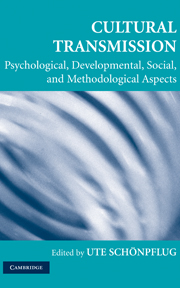Book contents
- Frontmatter
- Contents
- Foreword
- Contributors
- 1 Introduction to Cultural Transmission: Psychological, Developmental, Social, and Methodological Aspects
- 2 Theory and Research in Cultural Transmission: A Short History
- PART ONE EVOLUTIONARY PERSPECTIVE
- PART TWO CROSS-CULTURAL PERSPECTIVE
- 6 An Ecocultural Perspective on Cultural Transmission: The Family across Cultures
- 7 Intergenerational Relations and Cultural Transmission
- 8 Intergenerational Transmission, Social Capital, and Interethnic Contact in Immigrant Families
- 9 Developmental Processes Related to Intergenerational Transmission of Culture: Growing Up with Two Cultures
- 10 The Transmission Process: Mechanisms and Contexts
- 11 Accounting for Parent–Child Value Congruence: Theoretical Considerations and Empirical Evidence
- 12 Culture, Migration, and Family-Value Socialization: A Theoretical Model and Empirical Investigation with Russian-Immigrant Youth in Israel
- 13 Immigrant Parents' Age Expectations for the Development of Their Adolescent Offspring: Transmission Effects and Changes after Immigration
- PART THREE INTRACULTURAL VARIATIONS
- Index
- References
13 - Immigrant Parents' Age Expectations for the Development of Their Adolescent Offspring: Transmission Effects and Changes after Immigration
Published online by Cambridge University Press: 05 June 2012
- Frontmatter
- Contents
- Foreword
- Contributors
- 1 Introduction to Cultural Transmission: Psychological, Developmental, Social, and Methodological Aspects
- 2 Theory and Research in Cultural Transmission: A Short History
- PART ONE EVOLUTIONARY PERSPECTIVE
- PART TWO CROSS-CULTURAL PERSPECTIVE
- 6 An Ecocultural Perspective on Cultural Transmission: The Family across Cultures
- 7 Intergenerational Relations and Cultural Transmission
- 8 Intergenerational Transmission, Social Capital, and Interethnic Contact in Immigrant Families
- 9 Developmental Processes Related to Intergenerational Transmission of Culture: Growing Up with Two Cultures
- 10 The Transmission Process: Mechanisms and Contexts
- 11 Accounting for Parent–Child Value Congruence: Theoretical Considerations and Empirical Evidence
- 12 Culture, Migration, and Family-Value Socialization: A Theoretical Model and Empirical Investigation with Russian-Immigrant Youth in Israel
- 13 Immigrant Parents' Age Expectations for the Development of Their Adolescent Offspring: Transmission Effects and Changes after Immigration
- PART THREE INTRACULTURAL VARIATIONS
- Index
- References
Summary
INTRODUCTION
Immigration often takes place from traditional developing countries into modern industrialized cultures and is related to a whole range of changes in the living conditions of an individual. The confrontation with an unfamiliar value system is one of the most important challenges in the life of an immigrant (Schmitt-Rodermund & Silbereisen, 2008). Whereas adolescents tend to adjust relatively quickly to such a situation – in part because of their higher competence in language acquisition – their parents sometimes have more trouble developing new perspectives and acquiring new skills (Feldman, Mont-Reynaud, & Rosenthal, 1992; Süss, 1995). Unemployment of the breadwinner may add to a situation of shifted roles within the family in favor of the adolescents (Hehl & Ponge, 1997). The goal of this chapter is to shed light on the process of adaptation for parents of immigrant adolescents. The target group of the study consists of ethnic Germans who arrive in what they deem their country of origin from states that were formerly known as the Eastern Bloc. However, their ancestors have lived in Russia, Poland, or Romania for many generations and, therefore, they can be considered true immigrants (Silbereisen & Schmitt-Rodermund, 2000). They have kept their in-group language of German and customs (e.g., the celebration of Christmas). This group is being studied to clarify issues related to value orientations, especially age expectations or timetables for adolescent developmental transitions to behavioral autonomy.
- Type
- Chapter
- Information
- Cultural TransmissionPsychological, Developmental, Social, and Methodological Aspects, pp. 297 - 314Publisher: Cambridge University PressPrint publication year: 2008



